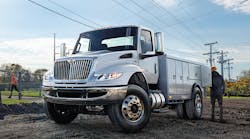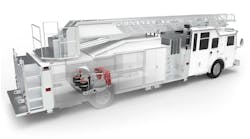The speed at which truck manufacturers are developing new technologies is staggering. While many of the big trends keep circling the industry – electrification, automation, connectivity – the race to the finish line seems far off. But collectively, the industry continues to take incremental steps toward the development of products covering all these trends. Whether it’s the shift to electronic stability control, the ever-increasing adoption of automated manual transmissions or the advancements in remote diagnostics and programming, it’s safe to say change is happening and will continue.
When it comes to heavy duty commercial vehicles, there are distinct trends to serve this market. But the fact remains, just like all vehicles on the road, driver safety and vehicle efficiency top the list of forces behind these changes.
Particularly with heavy duty trucks, driver comfort has come hand-in-hand with driver safety. Adjustable seat, steering wheel and dash options can provide ergonomic benefits for all types of drivers. This is an especially important point when addressing the industry’s driver shortage. If a truck can accommodate all types of drivers, there’s a better chance it will be operated.
When it comes to economic and business trends, heavy duty truck orders have been at record levels since the beginning of 2018.
“[The] first quarter 2018 U.S. and Canada Class 8 truck industry orders were more than double the same period last year,” says Gary Moore, Paccar executive vice president. Paccar is the parent company for both Kenworth and Peterbilt brands. “The truck market reflects the strong economy and excellent freight demand.”
While many anticipate an eventual slow-down, this influx of orders has created increased lead-times for build dates.
“What we have also seen is the long haul segment has increased,” says Magnus Koeck, vice president, marketing and brand management for Volvo Trucks North America. “That’s the largest segment overall. Long haul is continually growing. Regional haul has also gone very well.”
This growth may be attributed in part to the “Amazon Effect,” with the increased economic boost to online retail purchases.
With moderate long-haul growth, Gary Jones, president of Rainier Truck & Chassis, commented, “leasing [may become] more cost-advantageous to fleets as new truck models become more technology-driven and expensive to diagnose, repair and train on.”
OEs are seeing a shift from sleeper cabs to day cab orders in the Class 8 market as well, according to Jim Nachtman, International’s product marketing director for on highway trucks.
While there are certain trends topping the list, there are always certain needs specific to the fleet. This article serves as a resource of recent updates to the heavy duty trucking segment, specifically for Class 7and 8 vehicles.
Note: Heavy duty trucks in this article are defined as Class 7 (26,001 to 33,000 lbs GVW) and Class 8 (more than 33,001 lbs GVW). While some classify Class 6 vehicles as 'light heavy duty,' in this article we are following Federal Highway Administration classifications.
Autocar Trucks
Autocar focuses on custom built trucks for specific applications. With this approach, the company says it can provide short delivery times, reliable vehicles and low operating costs. “All our product improvements are targeted to deliver substantial financial improvements in those areas,” says Adam Burck, vice president of brand management for GVW Group, the parent company of Autocar Trucks.
Autocar offers three truck models: the ACX, ACMD and ACTT.
The Autocar ACX Class 8 cabover offers configurations from 4x2 to 10x6, with twin-steer and triple-steer axles, and other custom configurations to suit customers’ needs. The ACX is designed for severe duty applications.
With recent updates to the ACX, fleets can now spec the Cummins L9N Near-Zero NOx engine, or the Cummins X12 diesel engine. The X12 provides more torque, a weight reduction of 700 lbs and lower operating costs, according to Burck.
“Fuel savings alone are worth over $10,000,” he adds. The ACX also now has available the Hendrickson Steertek NXT front axle and integrated suspension system with improved payload for front-end-load trucks, as well as improved handling and ride. In addition, the ACX has an optional fuel management module prep-kit for CNG trucks.
The Autocar ACMD Class 7/8 cabover is available in configurations from 4x2 to 6x4. The ACMD is designed for refuse and recycling, road maintenance, street sweepers and aircraft support.
Recent updates to the ACMD include the Cummins L9N Near-Zero NOx engine spec, along with chassis-mounted steps for safer and easier entry and exit and roof-mounted auxiliary A/C for extreme climates.
The Autocar ACTT is a terminal tractor with configurations from 4x2 to 6x4, designed for freight handling, rail yards and terminals, intermodal and ports. Recently added features for the ACTT include 65 mph capability and cruise control, a new hydraulic system control valve for improved reliability, white noise back-up alarm and Autocar’s proprietary safety glass.
Freightliner
“We’ll continue to see trucks offering more driver-friendly features to make the work environment as appealing and as productive as possible,” says Kelly Gedert, director of product marketing, Freightliner Trucks and Detroit Components. Freightliner is a division of Daimler Trucks North America. In addition to cab design, a big proponent of easier operation, especially for new drivers, will be the Detroit DT12 automated manual transmission.
The company’s flagship long-haul tractor, the Freightliner Cascadia, now has the ability to receive over-the-air Detroit Connect Remote Updates. This functionality allows fleets to update parameters on the new Cascadia for items like road speed, cruise speed, idle shutdown by time and idle shutdown by temperature.
Freightliner also introduced a compressed natural gas (CNG) day-cab option available for the Cascadia during ACT Expo 2018. For the powertrain, this CNG option features a Cummins Westport ISX 12N Near Zero (NZ) NOx natural gas engine, with up to 400 hp and 1,450 lb-ft of torque, and an Eaton Fuller Advantage Series automated manual transmission.
In April 2018, Freightliner introduced the EconicSD waste collection truck.
“The Freightliner EconicSD has as unique low-entry concept that includes a kneeling and lifting function which further reduces its already low step-in height,” Gedert says. “The panoramic view allows for easy navigation, and the thoughtfully-designed cab is spacious and modern, with an intuitive digital instrument cluster.”
The EconicSD features a Detroit DD8 engine with Detroit Connect Virtual Technician remote diagnostic service, along with an Allison 3000 series six-speed automatic transmission with PTO capability. With a 6x4 axle configuration, cab style options include high cab, low cab with front, rear or side loader configurations.
Hino
Officially unveiled at the Work Truck Show 2018, Hino Trucks entered into the Class 8 market with the introduction of the Hino XL Series. Available in Hino XL7 and XL8 models, both are powered by Hino’s A09 turbo diesel 8.9L inline 6-cyl engine. This engine provides a horsepower range of 300-360 hp, with a torque rating between 900 and 1,150 lb-ft.
The Hino XL Series will be available in numerous straight truck and tractor configurations ranging from a GVWR of 33,000 to 60,000 lbs, and GCWR up to 66,000 lbs, with max performance of 360 hp and 1,150 lb-ft of torque.
Designed for a number of vocational applications as well, the XL Series offers wheel base options of up to 304”, with tandem axle and fifth wheel configurations.
The XL Series features electronic stability control standard on all tractors. Additional active safety feature options include a radar-based collision mitigation system with active braking and a camera-based lane-departure warning system. Production of the XL Series will begin in 2019.
With a 33,000 GVW, Hino also recently announced the 338 Class 7 truck designed specifically for delivery, utility and refuse applications. The 338 features the Hino J08E VB 260hp engine with a maximum 660 lb-ft of torque. Driveline components include an Allison Transmission automatic 6-speed transmission, Meritor axles and Dana Spicer driveshafts.
International Truck
Also announcing the launch of a new product at the Work Truck Show 2018, International Truck introduced its Class 6/7 International MV Series. The MV Series is the last of the company's Project Horizon initiative to relaunch its product line. The MV Series features upgrades to cab design and other driver-centric enhancements also included in the company’s Class 8 lineup.
When it comes to drivetrain, fleets have a choice between the Cummins 6.7 or L9 engine, and the Allison Transmission 1000 HS automatic transmission. The Allison FuelSense 2.0 with DynActive Shifting, a torque converter allowing for any number of shift points based on operating conditions, is also optional.
Available cab designs include regular cab, extended cab and crew cab. In terms of cab design, International focused on optimal views with a single large piece of windshield glass to improve visibility and reduce blind spots. Other updates include a new digital display gauge cluster with the ability to customize up to 15 digital gauges, as well as a new digital instrument panel to customize to multiple applications. In addition, a flat-panel dash allows space for up to 30 customizable switches.
When it comes to custom programmable chassis electronics, the Diamond Logic electrical system allows fleets to streamline chassis and body equipment integration and the ability to program automated tasks.
Available on all International Trucks, including the MV Series, advanced remote diagnostics and over-the-air programming are available through the OnCommand Connection platform.
“Although the International A26 engine was launched in 2017, it has accounted for driving share growth in the 13-liter segment of the Class 8 market, nearly doubling our 13-liter share from Q1 a year ago,” says Jim Nachtman, International’s product marketing director for on highway trucks.
Kenworth
Kenworth, a Paccar company, continues its focus with the on-highway T680 and vocational T880, with a special emphasis on the rollout of the Paccar 12-speed automated transmission.
“In 2017, approximately 70 percent of our line haul customers purchased automated transmissions, up from about 30 percent in 2013,” Kurt Swihart, Kenworth marketing director, says. “We received a very positive response from fleets involved during the Paccar transmission’s testing and validation program.”
In terms of axle lineup, Kenworth now offers front axles with standard track options of 20,000-lb and 22,800-lb, ideally suited for the Kenworth T880 and other Kenworth Class 8 vocational models.
Entering into the alternative fuels market, Kenworth also recently introduced two cargo transport vehicles: the T680 HECT (Hybrid Electric Cargo Transport) tractor and the T680 ZECT tractor.
Debuted at ACT Expo 2018, the T680 HECT features a parallel hybrid electric propulsion system using the Cummins Westport ISL G Near Zero emission CNG engine combined with a generator for extended range. Using electricity stored in the onboard lithium-ion batteries, the truck has a 30-mile zero emissions range. Once the battery is depleted, the Cummins Westport engine would provide an additional range of 250 miles.
Introduced at the 2018 Consumer Electronics Show, the T680 ZECT tractor runs on a hydrogen fuel cell. It works by combining compressed hydrogen gas and air to produce electricity.
Mack Trucks
Mack Trucks began production of its Mack Anthem, designed specifically for on-highway use. Several configurations are available including a day cab, 48” flat top sleeper and 70” stand-up sleeper.
Constructed of only three pieces each, the Anthem features a redesigned hood and bumper to improve aerodynamics and aid in decreased service time or pre-trip inspections.
All interior and exterior lighting comes standard as LEDs as well.
The Mack Anthem comes standard with the 2017 MP series engine. Fleets can opt for the 13L Mack MP8 engine, providing 505 hp and 1,860 lb-ft of torque, or the 11L Mack MP7 engine, with up to 425 hp and 1,560 lb-ft of torque. An optional SuperEconodyne downspeeding package is available for both engines.
The 12-speed mDRIVE automated manual transmission comes standard. An optional 13-speed or 14-speed mDRIVE HD with low-ratio creeper gears is also available for applications requiring more frequent shifting or heavier loads.
Both engines feature serviceability enhancements, like a two-piece valve cover, shimless rockers and low-pressure fuel system with an integrated aftertreatment dosing module. In addition, an updated double-walled EGR flow sensor helps with reducing cold weather condensation and soot buildup. A new intake throttle also enables faster warmups at engine ignition.
Mack Trucks added Over the Air remote diagnostics and programming capabilities to its Mack Connect software suite. Other functionality already available with Mack Connect includes the Mack GuardDog Connect telematics and Mack ASIST service management system. For all Mack Trucks featuring 2017 or newer engines, the Over the Air remote software functionality provides fleets the ability to update powertrain components and vehicle parameters.
Customers can contact Mack’s Uptime Center to schedule the updates at their convenience.
Peterbilt
Based off of the company’s Model 579 design, Peterbilt introduced the UltraLoft 80” integral on-highway cab and sleeper design earlier this year.
Peterbilt is a division of Paccar.
The sleeper features a double bunk with 48” clearance on the lower bunk and 39” clearance on the upper bunk, 70 cu. ft. of storage and a closet space with 42” hanging height.
“One of the ways fleets solve the driver shortage is to bring less experienced drivers into their fleets and put them through the driver programs," Kyle Quinn, general manager, Peterbilt Motors Co., says. "The 579 is exactly what’s needed for these solutions to train the driver over time."
A subsequent result of the SuperTruck One program, the introduction of the EPIQ package available to spec on all Peterbilt 579 models – including the UltraLoft – provides features such as better aerodynamics, predictive cruise control and a more efficient integrated Paccar powertrain providing larger fleets the performance they look for to improve operating costs.
Offering the EPIQ package on the recently launched 579 UltraLoft acknowledges the company’s continued commitment to providing more fuel efficient trucks. Spec'd on the 579 UltraLoft, the EPIQ package provides 2 percent improvement on aerodynamics and 1 percent better fuel economy than the company’s discrete sleeper models.
For the vocational market, Peterbilt remains committed to clean energy with the discussion on an all-electric refuse truck. The Model 520 all-electric provides an 80-mile range on one six-hour charge, with 400 hp electric motor and four battery modules with 315 kWH capacity. Peterbilt is currently testing 16 trucks in LA County.
Also with regards to vocational applications on traditional models, Peterbilt vocational trucks now have the option of spec’ing the Paccar 20,000-lb and 22,000-lb standard track version steer axles.
Rainier Truck and Chassis
Particularly due to the recent boom in e-commerce deliveries, Gary Jones, president of Rainier Truck and Chassis predicts an upswing in Class 7/8 cabovers for intercity delivery applications, where a conventional truck has trouble maneuvering.
Branching into the heavy duty market, Rainier has added a Class 7 version to its lineup. The company also updated the exterior look of all truck models beginning with 2018 production.
"All Rainier [cab-over-engine] truck models share a rugged and reliable common chassis-cab platform,” Jones says. “This was intentional to help dealers and customers keep the overall cost of doing business down.”
Intended for delivery, service and refuse applications, Rainier vehicles come standard with the following:
- Cummins B 6.7L turbo-charged diesel engine, with 300hp and 660 lb-ft of torque
- Allison 2500RDS 6-speed automatic transmission with push-button shift selector
- 12V electrical system
- Air brakes with auto slack adjusters
- Four-wheel, four-sensor ABS with traction control
- Air ride driver and passenger side seats
- LED high/low beam headlamps, clearance and marker lamps
- Heated air dryer, heated remote fuel filter and heated moisture ejectors for air tanks
Fleets have a choice of load leveling air ride for front and rear suspensions or leaf, with no up charge, and a choice of any wheel base with no up charge.
Volvo
Within the course of a year, Volvo has relaunched all three of its distinct models: the VNL for over the road and long haul, the VNR for regional haul and the VNX for heavy haul.
All three truck models share consistency in driver comforts and shared interiors. Volvo Active Driver Assist is now standard for VNR and VNL models. Utilizing radar and cameras, this safety system features the Bendix Wingman Fusion, and is a combination forward collision mitigation system, adaptive cruise control and a lane departure warning system. In addition, all come standard with the I-Shift automated manual transmission.
In 2017, Volvo introduced Remote Programming capabilities for 2018 model year trucks, allowing fleets to provide vehicle system updates including parameter changes. While Remote Diagnostics has been available since 2012, last year Volvo introduced the functionality for legacy vehicles as well.
“Imagine standing in line every time you have an update [for your smartphone]," says Magnus Koeck, vice president, marketing and brand management for Volvo Trucks North America. "It is huge to have remote updates in terms of uptime. We are working heavily with more connectivity services going forward.”
VNR
New features for the VNR regional haul series include proprietary tilt steering wheel akin to a passenger vehicle, allowing for more driver customization, along with ergonomic seats and an updated driver display with new instrument cluster and infotainment system.
The VNR includes the Volvo I-Shift automated manual transmission and the I-See predictive cruise control. The VNR model is designed for urban pickup and delivery, bulk transport, flatbed, tankers and port drayage.
VNL
The VNL long-haul series also features a tilt steering wheel attached to the company’s Perfect Position air-assisted adjustable steering column allowing for numerous steering wheel positions based on the driver’s need.
As for the drivetrain, the VNL series comes standard with The 13L Volvo D13 engine. Daycab and VNL 400 models also have an optional 11L Volvo D11 spec. In addition, fleets may opt for the 15L Cummins X15. For the D13 and D11 engine specs, a turbo compound option is also available, in addition to an optional downspeeding package for added fuel efficiency.
Four sleeper cab configurations are available for the VNL.
VNX
Designed for heavy haul applications, the VNX series is available in three cab configurations:
- VNX 300 daycab, designed for local heavy haul applications
- VNX 400 flat-roof regional sleeper, designed for intermittent overnight use
- VNX 740 70” sleeper, designed for long distances
Trucks in the VNX Series come standard with the Volvo D13 engine, providing 500 hp and 1,850 lb-ft of torque, along with the 13- or 14-speed Volvo I-Shift automated manual transmission with crawler gears.
An optional Cummins X15 Performance Series engine, paired with an Eaton Ultra Shift Plus or manual transmission is available for spec as well, providing up to 605 hp and 2,050 lb-ft of torque.
A number of optional steer, lift and tridem drive axles configurations, along with longer fifth-wheel slides, are available to meet a range of weight distribution requirements. Overall, the VNX is rated at a 125,000 to 160,000-lb Gross Combination Weight Rating (GCWR), with ratings up to 225,000 lbs available with application approval and correctly spec’d components.
Western Star
While the truck manufacturer hasn’t introduced any new models recently, Western Star, a division of Daimler Trucks North America, has provided a number of updates and options now available on existing models. Some of those updates include:
- RollTek Seats: Designed as an extra safety parameter to protect the driver in the event of a rollover situation, the Rolltek seat system will inflate side-impact airbags, tighten seatbelts and compress air suspension seats to the lowest position. RollTek Seats are available to spec on 4700, 4800 and 4900 truck models.
- Sealed frame rails: Designed to help minimize rust and reduce corrosion, this flexible water-tight seal prevents liquids from penetrating the vehicle body. Available for 4700, 4800 and 4900 truck models.
- Abrasion Tape for Exterior Harnesses: Designed for construction, logging and road maintenance applications where abrasion in the chassis may occur. Available for 4700 and 5700 truck models.
- Detroit 23,000-lb Front Steer Axle: This front steer axle is designed for snow plows, dumps and heavy haul, and other applications requiring a higher front axle weight rating. Available for 4800 and 4900 truck models.
- Five-man crew cab: Available with either two or four doors. Available for 4700, 4800, 4900 and 6900 truck models.
- In-Cab four-battery box: Storage under the passenger seat helps protect the batteries while providing expanded capacity. Available for 5700XE day cabs.
Conclusion
As additional greenhouse gas regulations for the coming years – 2020, 2024 and 2027 – come into play, the industry will see additional steps to improve fuel economy when it comes to heavy duty vehicles.
Advanced technologies like vehicle connectivity, electrification and automated driving functionality will play an ever-larger role to increase safety and improve fuel economy.




